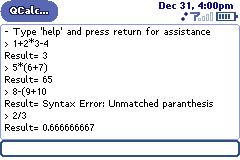

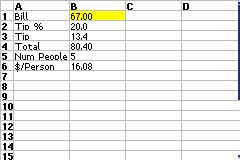
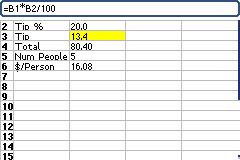

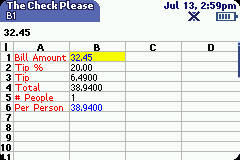

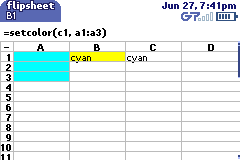
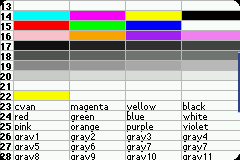

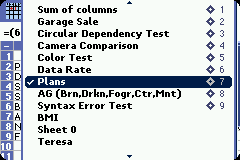



Hipme.com was a site I used for software for the Danger Hiptop platform from 2003 to 2005.
Below are descriptions, screenshots, and for the first time ever, source code, for the apps I wrote for the Danger Hiptop platform in 2003-2004.
The Hiptop pre-dates the Apple iPhone by several years. The Danger / Hiptop / Sidekick platform had the first apps and app store ("Catalog"). After leaving Danger, Andy Rubin and several of the team founded Android, and he sold that to Google where he then built what we now know as Android. Many ideas from Android are seen in early stages here in the hiptop, the app catalog, including the use of Java as an implementation language but a different VM implementation, and the use of Intent (which sprang from, among other things, requests I made about my flipsheet program being able to handle email CSV attachments).
I wrote the following apps and have them here for historical reasons. I believe I can call these the first true apps of their kind.
I have released the source for these under MIT OSS license, except for one file in flipsheet which is decompiled and adapted from one of the Hiptop widgets, adding a horizontal scroll to an existing scroller. For this, I can offer no license other than to say this is really only of academic interest.
See others below for apps other people wrote and for which I still have source.
Flipsheet was my most complex app, and the only one that Danger and T-Mobile considered selling. It was quite popular around the Danger HQ offices, but once the sales program actually got underway, T-Mobile (the main partner) decided that they did not want productivity apps, only games and ringtones, and I got a phone call one day turning me down. Six months later they changed their mind and wrote their own.


![]()












Towerdata and Secrets were data collection for the very first location-aware apps.
I noticed that it was possible to obtain the GSM tower id and sector from the Hiptop OS in development mode, and I wanted to write apps that would let you do something with that information. My first thought were finding other hiptop users nearby so you could hang out with them (the Hiptop was a social phenomenon and people wanted to find each other). I also thought that keep track of where you took pictures or wrote messages to Mike Popovic's Hiptop Hation would be great. And I thought that it would be good to send messages so people who you were communicating with via IM, to share your location.
But to do all this I needed to collect tower location data so I wrote this app and my wife Becky wrote the SQL backend.
I faced a big problem, though: the on-device tower ID call was blocked. By calling the Linux strings command on the Hiptop SDK linker, I found a secret flag that let you override this restriction. I showed my location-aware apps to Andy Rubin, but he told me that phone carriers had put them all on hold because of "privacy concerns." I later found a GSM association whitepaper that was 75 pages long, with 25 pages on how to charge people $1 and advertisers $1 to connect the two, 25 more pages on how to prevent people from getting their location without paying $1 to the carrier, and the final 25 pages on how to get the location data on subscribers from roaming partners while simultaneously preventing the roaming partner from getting it. So, the carriers were basically spending all their time and energy trying to prevent things from happening before they could figure out how to own it all.
So, sadly, location-aware apps on the Hiptop platform were all stillborn. I found out that Danger had started a similar project, called "Dogs" as in, "Who let the dogs out?" from a popular song of the time, which is why Andy Rubin knew it wasn't going to fly with the carriers. So, that's why Android had the secret API for getting tower data, and why it was disabled, and why my location app wasn't the first.
Download Source for Towerdata (database / server)
Download Source for Secrets (hiptop / client)
As far as I know, Tower Power (cellinfo) was the very first location-aware app showing maps and points of interest. I wrote it in September 2003 and stopped working on it in March 2004, when T-Mobile decided against LBA apps on the Hiptop platform.
Download Source for Tower Power / Cellinfo
Here is an example of it showing a query for finding nearby restaurants, followed by a map of results and a list of results:
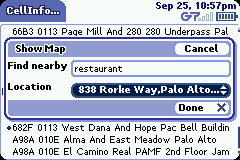
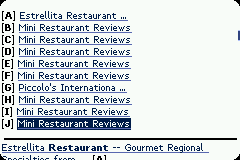


This is the menu showing the ability to add new tower locations, show all tower, show map, and get documentation:

This is a screen showing list of locations and the selected cell tower and sector. This information is averaged and used as the best indicator of current location when a tower is selected.

This is the app's splash screen in the Hiptop Launcher, showing the icons of other apps on left and the current app on the right.

Flipper was my first location-aware app. It was an IM client that used the Hiptop device-to-device reliable datagram service to send messages to friends. It supported sending location on demand, an @WRU command to retrieve location from a partner on demand, customized alerts and ringtones based on sender, and the ability to 'poke' a recipient and give a certain sound, photo attachments, and the ability to add appointments. All of this work predates anything that sounds like that that you've ever heard of. Apps like Couple and Avocado offer these facilities now, as do the various services like Apple iMessage. Flipper predates them all.
Download source code for flipper and flipper-next.
|
|
|
|
RPSK was a client program for amateur radio for PSK31, a digital communications mode used over high-frequency (HF) radio. It was the first amateur radio app ever, and the first digital PSK31 app ever.
It connected to a server that was hooked to a radio, and displayed an FFT spectrum waterfall display of the signals in the passband, the decoded PSK31 text, and the phase angle of each bit. It used a TCP/IP protocol to do this in realtime, over GPRS.
Download source code for rpsk.

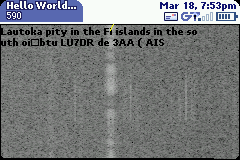

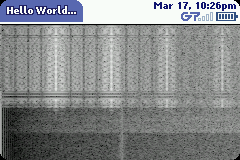
CW was a morse code program. Again, the first Morse-code app ever.
Download source code for cw.
I also offered other "Cloud" services that didn't require an app component.
received Outlook email and used cached username/password to add appointment to Exchange calendar. I used this myself and operated it as a service. I ended this service when Danger contracted for the development of a desktop-based Outlook Sync with Pumatech, the same company that did the Palm Pilot one, and when Paris Hilton's hiptop got hacked and I became concerned about the liability of holding on to these credentials as a hobbyist.
additional services for appointment.
Received email messages and posted them to Blogger.com blogs. All these photos were public because they were posted to Blogger.com and linked from there, where they were served up by my home server. When I shut the service down I contacted as many users as I could through their signup address, mailed them a link to a Zip file of their photos, and took the photos offline. I still have the photos, as they are of historical interest and were all public at one time.
a4est aar0n2k2 aaronpr ab3 ahaydenmill ameliathecat andreas appell babyblog bkchula718 bprats brianbear catchone ccahua celep cgingerich chalker chis chrislamb Chrislamb chulawitlipz070 chunks chunks2k5 cjmandrake ckrause coolcourt dannyt3988 dirtydogtavern drewtetz dzphone elks1859 elksblog enc er1859 foremank glypher gray hipblog hk hn iloader jeneane jenwolf jevans111 justinspohn klotz klotz-burwell liechty liquidswords lisasuzuki1 lucasc1 macesoul mail mattg1859 mcgambrell mistamitch mwendland nate nathanchase nickgray oliverk oneplus patrick paul1859 phatbudsjay poynter presto1129 quik rachel1420 rapidfire rd.robles remf3 richlin rickyv rlaurente robbie robbie59 robbiex rwashburn segovia Shadox shapiros shwsrh skipuhbeat snaughton spada spongebobmami87 stopper6 sub submit swtmo2k4 swtmonette2k4 tagblog teichenberg thomas.robinson tourjournal tritone uncle_chachi wa5znu WA5ZNU web yisdat zenblog zenzagg zklein
I retrieved and printed Fandango barcodes for movie tickets, formatted them for the Hiptop screen, and used them at the theatre. The black and white LCD Hiptop scanned well, but once I color one came out, the laser wand scanners at the theatres would not work. I succesfully used this at Century 16 Theatre in Mountan View on December 22, 2002.
Here are apps that other people wrote, probably none of which ever got into the T-Mobile store or any other Hiptop platform store. I have the source but can't release it until I get the OK from the authors.
Almost all of these are the first apps of their kind, ever. Even the alarm clock and calculator.

